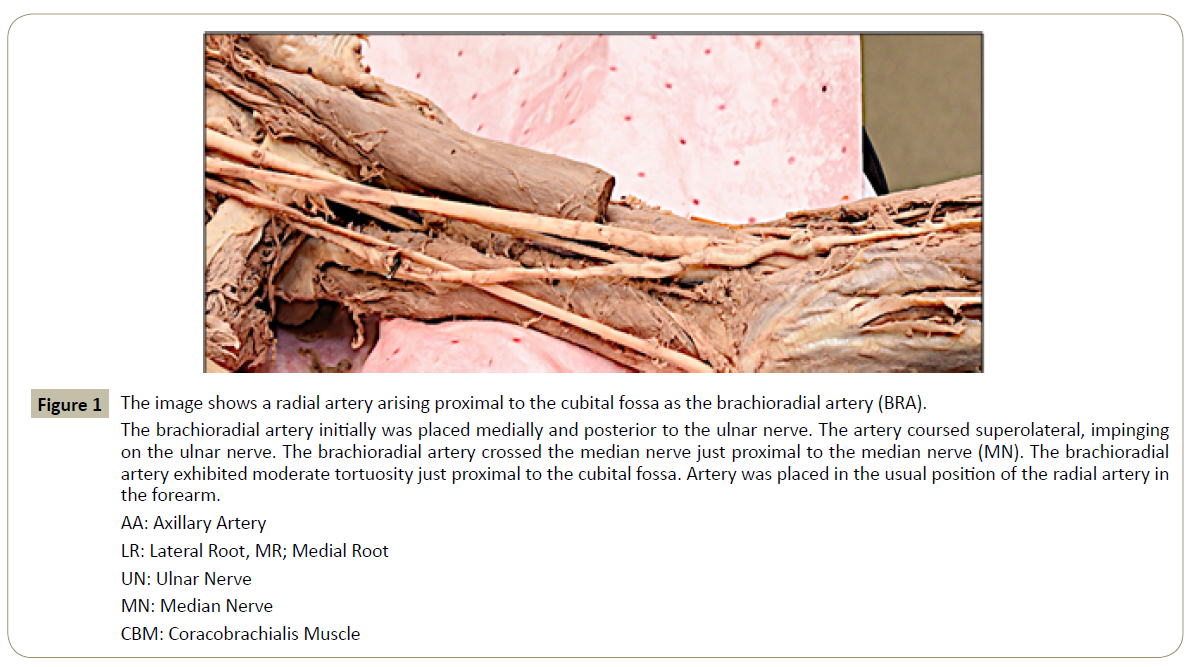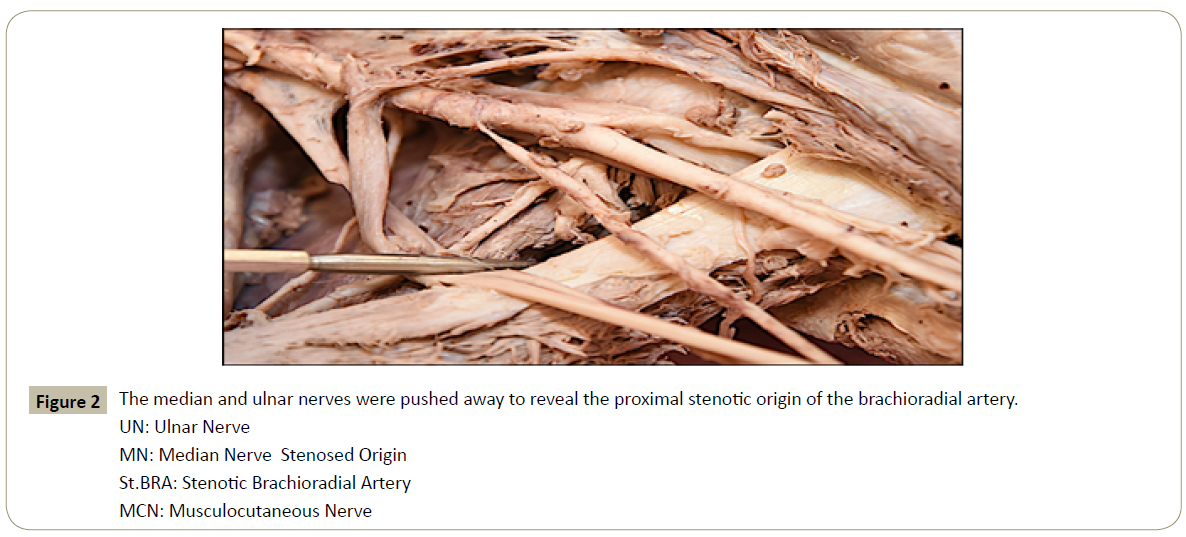Olutayo Ariyo*
Department of Pathology, Thomas Jefferson University, Philadelphia, PA 19107, USA
- Corresponding Author:
- Olutayo Ariyo
Department of Pathology
Thomas Jefferson University
Philadelphia, PA 19107, USA
E-mail: tmajor33@hotmail.com
Received Date: September 13, 2021; Accepted Date: November 02, 2021; Published Date: November 10, 2021
Citation: Ariyo O (2021) Multiple Morphological Radial Artery Variants with Odds of Increased Procedural Complications in Percutaneous Coronary Procedure and Clinical Implications. Interv Cardiol J Vol.7
No.10:153. doi: 10.36648/2471-8157.7.10.153
Copyright: © 2021 Ariyo O. This is an open-access article distributed under the terms of the Creative Commons Attribution License, which permits unrestricted use, distribution, and reproduction in any medium, provided the original author and source are credited.
Anatomic variants occurring in the radial artery often occur in singles, but
occasionally may have 2 or more co-existing variants. Some of the variants may
be etiologic in procedural complications when employed as vessel of choice in
percutaneous coronary procedure. We present a brachioradial artery with multiple
coexisting anatomic comorbidities that may increase probabilities of procedural
complications when employed as vessel of choice in transradial percutaneous
coronary procedure occurring in the left limb of a 68-year-old female cadaver.
Variants encountered included high origin, the artery arising medially from the
third part of the axillary artery (brachioradial), hypoplasty of the artery (diam.
< 1.8 mm) plus some moderate tortuosity occurring in the artery just proximal
to the cubital fossa, and more significantly, the artery presenting with a stenotic
proximal origin.
Artery at origin ran medially and posteriorly placed to the ulnar nerve, then
coursed superolateral, impinging on the ulnar nerve. Just proximal to the cubital
fossa, artery travelled some length anteriorly placed to the median nerve before
adopting the morphology of a normal radial artery in the forearm. Radial artery
presenting with multiple coexisting variants will likely increase odds of procedural
complications, including procedural elongation or failure in percutaneous
coronary procedure. Thus, documenting radial artery variants provides surgeons,
specialists, and radiologists with interventional insights.
Keywords
Percutaneous coronary procedure; High origin radial artery; Radial
artery stenosis; Tortuosity; Transradial vs transfemoral procedure; Procedural
complications
Introduction
Increasingly, the radial artery (TRA) is used over the femoral
artery (TFA) for percutaneous coronary procedure. Preference
of TRA over TFA has resulted from more favorable outcomes,
including fewer bleeding complications, better cost effectiveness,
decreased hospital stay, decreased mortality or morbidity rates,
and fewer access site complications [1].
Campeau (1989) was the first to use TRA as an alternative vessel
of access to TFA, reporting only a 2% unsuccessful rate; from this
Campeau predicted TRA may prove more effective and possibly
safer than TFA [2]. Kiemeneji and Laaman (1995) considered TRA stent implantation technique a safe approach, yielding high
success rates and low incidence of bleeding complications, even
during aggressive anticoagulation and confirmed TRA may be
associated with increased patient comfort and may facilitate
shortened hospitalization times and significant cost reduction
[3].
Based on the evidence, TRA and TFA are the two main approaches
used as a diagnostic and therapeutic purpose in catheterization.
During a complete institutional transition from TFA to TRA, Kadev
et al. (2014) compared the short- and long-term outcomes of
TRA versus TFA in primary percutaneous using cardiovascular
death and major adverse cardiac event (MACE) as primary end - points, a composite of death, stroke, reinfarction, and target
vessel revascularization, at 30 days and 1 year. At 30 days, TRA
compared to TFA was associated with a significant reduction
of cardiovascular mortality, significant MACE reduction, and
fewer access-site complications. At one year, the cardiovascular
mortality and MACE rates also favored the TRA group [4].
Roussanov et al. (2008) employed multiple categories in
determining cost-effectiveness, including access cost, catheter
cost, contrast cost, closure device cost, and recovery cost for the
TRA vs TFA to diagnostic cardiac catheterization; they reported
that access cost was significantly higher in the Radial Group,
catheter cost significantly lower in the TRA Group, contrast cost
significantly lower in the Radial Group, but closure device cost
significantly higher in the TRA than in TFA Group. Recovery cost
was reported significantly lower in the Radial Group compared
with the Femoral Group without closure device use [5].
Although TRA has numerous advantages over TFA, radial artery
variants including high origin, size, tortuosity, loops, and stenosis
are among the artery’s morphological anatomic features reported
etiologic in procedural complications, including procedural
elongation and failures. Other complications include longer
radiation exposure as concerns TRA [1]. The usual radial artery
begins 1 cm distal to the intercondylar line at the elbow, but the
artery may arise proximal to the elbow either from the axillary
artery (AA), or from the brachial and are called the brachioradial
artery (BRA), brachial, or superficial brachial artery (SBA). The BRA
is reported occurring in 1 of 7 individuals with a 13.8% incidence,
originating most frequently from the upper third brachial (65 plus
or minus 4%) [6]. Thus, recognizing arterial branching variations
in the upper limb can guide surgeons (orthopedics, vascular,
hand) and interventional cardiologists in selecting appropriate surgical interventions and assist neuroradiologists in interpreting
of mages.
Case report
In the differential diagnosis of nonspecific abdominal pain,
mesenteric ischemia is one of the first diagnoses that come to
mind [5]. As in our case, typical lesions (trombus, nonocclusive
lesion or embolism) were not observed in angiography of the
patient with mesenteric ischemic prediagnosis, it brought to mind
the diagnosis of MALS. To ensure the diagnosis before interfering
the stenosis, CTA was repeated and the diagnosis was confirmed.
Otherwise, if we interfered with the stenosis percutaneous,
it would be impossible to open the stent where the ligament
encircled and be iatrogenically embolized or the procedure
would result in complication like vascular injury that we could
not even think. We want to emphasize with our case that MALS
should be brought to mind when interfering mesenteric arteries.
The physicians dealing with vascular invasive intervention should
evaluate the lesions with clinical experiences and have skeptical
approach (Figure 1,2).
Figure 1: The image shows a radial artery arising proximal to the cubital fossa as the brachioradial artery (BRA).
The brachioradial artery initially was placed medially and posterior to the ulnar nerve. The artery coursed superolateral, impinging on the ulnar nerve. The brachioradial artery crossed the median nerve just proximal to the median nerve (MN). The brachioradial artery exhibited moderate tortuosity just proximal to the cubital fossa. Artery was placed in the usual position of the radial artery in the forearm.
AA: Axillary Artery
LR: Lateral Root, MR; Medial Root
UN: Ulnar Nerve
MN: Median Nerve
CBM: Coracobrachialis Muscle
Figure 2: The median and ulnar nerves were pushed away to reveal the proximal stenotic origin of the brachioradial artery.
UN: Ulnar Nerve
MN: Median Nerve Stenosed Origin
St.BRA: Stenotic Brachioradial Artery
MCN: Musculocutaneous Nerve
The main treatments of MALS are endovascular intervention,
open surgery (intraperitoneal and retroperitoneal), robotic and
laparoscopic surgery, coeliac ganglionectomy and percutaneous
coeliac plexus blockade [6-9]. Our case recuperated with open
surgery.
Conclusion
Multiple Morphological Radial Artery Variants with Odds of
Increased Procedural Complications in Percutaneous Coronary
Procedure and Clinical Implications is explains the proximal to the cubital fossa, artery travelled some length anteriorly placed
to the median nerve before adopting the morphology of a
normal radial artery in the forearm. Radial artery presenting with
multiple coexisting variants will likely increase odds of procedural
complications, including procedural elongation or failure in
percutaneous coronary procedure. Thus, documenting radial
artery variants provides surgeons, specialists, and radiologists
with interventional insights.
Acknowledgements
Dedicated to Prof. Raymond. J. Shea, a worthy mentor from whom
I learned a great deal of Anatomy and for his caring mentoring.
His approach to learning Anatomy, dubbed “Reconstruction
and Deconstruction,” is legendary. Immense thanks also to Ms
Pamela Walter MFA, Jefferson College of Life Sciences for the
helpful Editing and Resource guidance. To the wonderful donor,
appreciation for contributing to knowledge even in death.
References
- Anjum I, Khan MA, Aadil M, Faraz A, Farooqui M, et al. (2017) Transradial vs. TransfemoralApproach in Cardiac Catheterization: A Literature Review. Cureus 9: e1309.
- Campeau L (1989) Percutaneous radial artery approach for coronary angiography Catheter. Cardiovasc Diagn 16: 3-7.
- Kiemeneij F, Laarman GJ (1995) Transradial artery Palmaz-Schatz coronary stent implantation: results of a single-center feasibility study. Am Heart J 130: 14-21.
- Kedev S, Kalpak O, Dharma ST (2014) Complete transitioning to the radial approach for primary percutaneous coronary intervention: a real-world single-center registry of 1808 consecutive patients with acute ST-elevation myocardial infarction. J Invasive Cardiol 26: 475-8.
- Niedenfurhr MR, Vaquez T, Nearn I, Ferreira B, Parkin I, et al. (2001) Variations of the arterial pattern in the upper limb revisited : a morphological and statistical study, with a review of the literature. J Anatomy 199: 547-566.
- Lo TS, Nolan J, Fountzopoulos E, Behan M, Butler R, et al. (2009) Radial artery anomaly and its influence on transradial coronary procedure outcome. Heart 95: 410-415.
- Yoo BS,Voon J, Ko JY (2005) Anatomical consideration for transradial coronary procedures: Arterial diameter, branchinganomaly and vessel tortuosity. Int J Cardio 101: 421-427.
- Avdikos G, Karatasakis A, Tsoumeleas A, Lazaris E, Ziakas A, et al. (2017) Radial artery occlusion after transradial coronary catheterization. Cardiovasc Diagn Ther 7: 305-316.
- Peruga JP, Peruga JZ, Kasprzak JD, Krecki R, Jankowski L, et al. (2015) Ultrasound evaluation of forearm arteries in patients undergoing percutaneous coronary intervention via radial artery access results of one year follow up. Cardiol Pol 73: 502-510.



